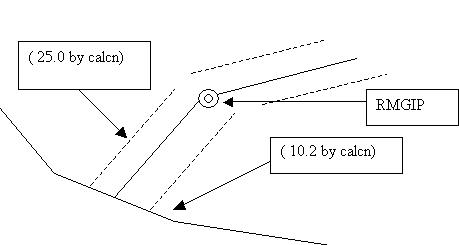Easements for structures located underground or within a building
Where an easement is to be created over an existing physical structure that is not readily visible (eg a tunnel, pipe, conduit, wire or other similar object which is underground or within or beneath an existing building) it is sufficient to indicate the site of the easement by a single broken line (appropriately designated) in the approximate position on the plan. No dimensions or width are shown on the plan to define easements of this type as the site comprises the physical structure of the pipes, conduits, wires etc., where ever they lie within the parcel. The notation approximate position should be added to the plan see s.88(1)(b) Conveyancing Act 1919 e.g.:
EASEMENT TO DRAIN WATER OVER EXISTING LINE OF PIPES (APPROXIMATE POSITION)
Note The site of an easement intended to exist only during the lifetime of any building or structure in which it is located, or which it benefits, may be related to a datum which is a substantial feature of the building or structure.
In all other cases the site of any physical structure referred to in a section 88B instrument (e.g. storm water detention basin, tree listed for preservation etc.) and which is shown on the face of the plan must be fully defined by dimensions and connected to a corner of a parcel.
Easements over an existing agricultural feature
An easement over an existing agricultural feature, e.g. 'open bore drain', may be created and defined in the same manner as an easement over a track in use. The site must be a physical feature easily identified on the ground of the affected parcel.
Easements for electricity purposes or telecommunications purposes over existing guy wires
An easement over an existing guy wire may be created and defined in the same manner as an easement over a track in use. The site must be a physical feature easily identified on the ground of the affected parcel. The site of the easement is to be shown by a broken line (appropriately designated) in the approximate position on the plan. No dimensions or widths are shown. The notation approximate position should be added to the plan see s.88 (1) (b) Conveyancing Act 1919.
Easement for electricity purposes over existing line of wires (approximate position)
Creation
The easement may be created by:
- A dealing registered under the Real Property Act 1900 based on either:
- a plan of survey or compilation registered as a deposited plan, or
- a compiled plan annexed to the dealing.
- A section 88B instrument lodged for registration with a new deposited plan, or
- A deed registered in the General Registry of Deeds (Old System) based on either:
- a plan of survey or compilation registered as a deposited plan, or
- a compiled plan annexed to the deed.
Plan requirements
There is an onus on the Registrar General to ensure that all easement plans are prepared with an accuracy that is relative to the purpose of the easement. NSW LRS has agreed to waive the usual requirement for a full deposited plan of survey to define the easement site provided any compiled deposited plan or compiled annexed plan complies with the requirements set out below. The surveyor preparing the plan must be satisfied that the accuracy of the plan provides adequate definition against all title and property issues. The easement site should be defined by either:
- a pegged centre line survey and make reference to Electricity Providers plan, or
- the centre line of existing line of poles.
The plan must:
- be prepared and signed by a registered surveyor.
- define the site of the easement by broken lines.
- show bearings and distances of the centreline together with the width of the easement.
- tie the site of the easement into the title (current parcel) boundaries by bearings and distances to parcel corners.
- if prepared on an approved plan form, have the surveyors certificate on the administration sheet amended to delete reference to a survey under the Surveying and Spatial Information Regulation 2012.
- include a statement as regards the method used to derive the location of the site of the easement, e.g. clause 9 survey, centre line of poles, pegged centre line etc, and
- be signed by all parties pursuant to section 195D Conveyancing Act 1919.
Alternatively, the easement may be created pursuant to clause 18 Surveying and Spatial Information Regulation 2012. All boundaries of the easement should be suitably defined by bearings and distances in the usual manner.
Compiled residue lots
Where a centreline survey affects a compiled residue parcel, the requisite reference marks defining the ends of the easement should be placed at the position of the last pole on the centreline and not on the compiled boundary itself. Approximate connections along the centreline from the new mark to the parcel boundary and then to the nearest parcel corner should be shown on the plan.

Example showing reference marks along a centre line in relation to a compiled boundary
Note Any request for an exemption to these requirements should be directed to NSW LRS plan and Title Advisor, for assessment. In these circumstances approval may be given for the preparation of a survey made pursuant to Clause 9 Surveying and Spatial Information Regulation 2012 (Surveys not requiring strict accuracy) to define the site of the proposed easement.